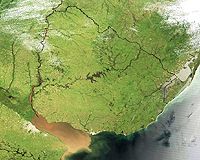| . |  |
. |
Paris (AFP) July 20, 2009 For generations, schoolchildren have been taught that raindrops start as micro-droplets that then gather together in clouds with their neighbours to become bigger droplets. Complex interaction between these droplets as they fall explains why raindrops come in such a remarkable range of sizes, goes this idea. But French scientists armed with ultra-fast video footage say something else happens on the way down -- and this is why rainfall can range from fine droplets to chubby plops. Initially, a raindrop starts to fall as a sphere, but then flattens out into a pancake shape. Eventually, as the pancake widens and thins, the onrush of air causes it to hollow out, like an upturned bag. The bag then inflates beyond the ability of the water's tension to hold things together and bursts into lots of smaller droplets. The whole process takes only several thousands of a second. But when the droplets hit the ground, the most numerous by far are very small, while large drops are comparatively few. "Rainfall does indeed start through coalescence in the clouds but something quite different happens on the way down, and this explains the diversity of raindrop sizes," said Emmanuel Villermaux, who co-wrote the study with Benjamin Bossa of the Aix-Marseille University in southern France. "Each drop breaks up individually, independently of its neighbours, on its way to earth." Way back in 1904, scientists noted that raindrops came in different sizes. The hypothesis was that droplets which bump into other droplets coalesce and become bigger, while smaller droplets are those that did not bump into as many other droplets. But the new paper, published online in the journal Nature Physics, says the process is in fact much simpler than thought. The findings could have practical applications in understanding rainfall patterns and in crop spraying, said Villermaux. "Understanding how droplets will be distributed can be very important. Take pesticide spraying, for instance. With most sprayers in use today, all it takes is a slight breeze for half of the pesticide to end up in the neighbouring field," he said. Share This Article With Planet Earth
Related Links Water News - Science, Technology and Politics
 UN court to hold hearings on Uruguay-Argentina river dispute
UN court to hold hearings on Uruguay-Argentina river disputeThe Hague (AFP) July 16, 2009 The UN's highest court said Thursday it would hold hearings from September 14 into a border dispute between Argentina and Uruguay. The International Court of Justice (ICJ) said in a statement the public hearings would last until October 2. Argentina filed an application with the court in May 2006, accusing Uruguay of having unilaterally authorised the construction of two paper mills ... read more |
|
| The content herein, unless otherwise known to be public domain, are Copyright 1995-2009 - SpaceDaily. AFP and UPI Wire Stories are copyright Agence France-Presse and United Press International. ESA Portal Reports are copyright European Space Agency. All NASA sourced material is public domain. Additional copyrights may apply in whole or part to other bona fide parties. Advertising does not imply endorsement,agreement or approval of any opinions, statements or information provided by SpaceDaily on any Web page published or hosted by SpaceDaily. Privacy Statement |